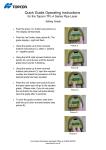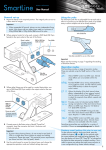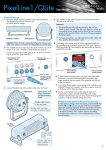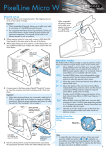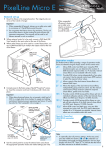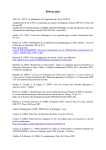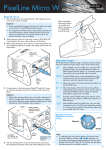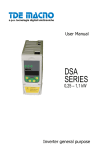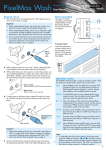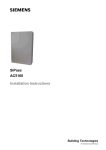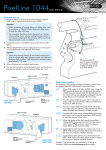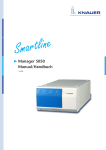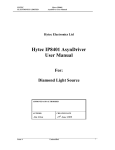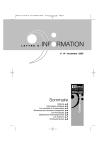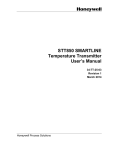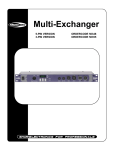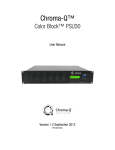Download User manual version 1.64
Transcript
SmartLine Version 1.64 firmware User Manual General set up 1 Mount the fixture in the required position. The integral yoke can act as a floor stand or hanger. Important Using the yoke The SmartLine yoke has an adjustable foot at each end to allow it to function as an effective floor stand or be folded away to allow multiple units to be closely stacked. • When suspended off ground, always use two independent fixing points. Also always use two safety wires rated to a minimum of 40kg (88lbs) SL6 or 30Kg (66lbs) SL4 through the wire lugs. Yoke folded flat 2 Where external control is to be used, connect a DMX lead (XLR 5-pin female) to the input socket at the rear of the fixture. Power in socket Connector required: Neutrik® PowerCon® (NAC3FCA) DMX in (XLR 5pin male) connector Fuse holder Electrical test earth point Yoke feet extended for use as a floor stand Important Safety wire lug Please see the warning on page 10 regarding the stacking of SmartLine fixtures. Operation modes The SmartLine provides a range of operation modes. These are selected using the MODE section of the control menu: Body tilt lever Yoke foot locking knob DMX Allows RGBW control via DMX input. Internal chase effects are not available within this mode. MANU Provides RGBW colour mixing independently of any external control. Use the internal control menu (MAN section) to select the required colour values. EF M Allows the display of the dual internal chase effects, independently of any external control. Use the internal control menu (PROG section) to select the required chase effects, speeds and cross fades. 96+E 144+ Provides control of individual emitter RGBW mixing and selection of the dual internal chase effects via DMX input. Requires 104 (SL4) or 152 (SL6) DMX channels. 4+E Provides control of RGBW mixing and selection of the dual internal chase effects via DMX input. Requires 11 DMX channels. 16bt Allows RGBW control via DMX input, using two 8bit channels per colour. Internal chase effects are not available within this mode. 3 Where other fixtures are to be used in a control daisy-chain, connect a DMX lead (XLR 5-pin male) to the output socket at the rear of the fixture. DMX out (XLR 5pin female) connector Power out socket Connector required: Neutrik® PowerCon® (NAC3FCB) 4 Connect power to the fixture using a Neutrik® PowerCon® connector. Insert the connector and twist it clockwise until it clicks into place. Important • If power daisy-chaining fixtures, do not exceed a total load of 3kW in a single daisy chain (subject to supply and cabling restrictions). Please see page 10 for maximum power requirements per fixture. 5 Use the control panel to access the internal menu and choose the appropriate operation mode and related settings (see over). SmartLine personalities are available for a variety of controllers. Please see www.pixelrange.com for details. Factory reset (perform this prior to new use) To clear previous settings: At the rear panel, press the middle two buttons ( and ) for two seconds while the current address and mode are being displayed. The four digit display will show FACT then SET to indicate that the fixture has been returned to its default condition. This is useful to remove any settings that might cause confusion in a new configuration (e.g. master intensity settings). 1 General notes Using the menu • Ensure that only one DMX • When not in the menu, the four digit display scrolls the device in the chain is set as master (e.g. the lighting desk). This fixture is usually set to slave mode. •This fixture is shipped with the DMX address set to 001. •The four digit display can be set to switch off when not in use. To restore, press . To alter this mode use: PERS > DISP. current DMX address and mode. The display’s right hand decimal point (data dot) is used to indicate status (see below). MENU ENTER DOWN •Press to enter the menu. The four digit display will show ADDR. •Use and to move between menu options (or to change a value within an option). UP •Press to enter an option (or to fix a changed value within an option and return to the previous option level). Note: If you do not press to fix a value, operation will revert to the previously set mode at the next power on. www.pixelrange.com *Refer to product manual for proper operating instructions •Press to exit from a menu option (and eventually exit the menu completely). Chase effects Master/slave/data indication This section describes each of the internal chase effects that are selectable either via the control menu (PROG > C1/C2 > EFEC) or using DMX values sent from an external source. To use the internal effects, set the MODE option either to EF M (for internal menu control) or 4+E, 5+E or 61+E (for external DMX control). The right hand decimal point (data dot) of the display is used to indicate the master/slave settings and also the presence of a DMX input signal, as shown below: DMX EFEC Chase effect description valuevalue 0-3 00Off 4-7 01 Rainbow forward chase 8-11 02 Rainbow reverse chase 12-15 03 Cool white forward chase 16-19 04 Cool white reverse chase 20-23 05 Cool white outer/inner/outer chase 24-27 06 50/50 duty cycle cool white strobe 28-31 07 50/50 duty cycle red strobe 32-35 08 50/50 duty cycle purple strobe 36-39 09 50/50 duty cycle yellow strobe 40-43 10 50/50 duty cycle green strobe 44-47 11 Pulse white strobe 48-51 12 Pulse light blue strobe 52-55 13 Pulse rainbow strobe 56-59 14 Pulse red/green/blue strobe 60-63 15 Rainbow forward strobe (cells together) 64-67 16 Rainbow reverse strobe (cells together) 68-71 17 Yellow/blue strobe (cells together) 72-75 18 Horizontal split rainbow chase 76-79 19 Multi cell yellow/blue chase 80-83 20 Multi cell red/blue chase 84-87 21 Multi cell red/yellow chase 88-91 22 Multi cell RGB forward chase 92-95 23 Multi cell rainbow forward chase 96-99 24 Multi cell RGB reverse chase 100-103 25 Static salmon pink 104-107 26 Static yellow 108-111 27 Static light blue 112-115 28 Static purple 116-119 29 Static red 120-123 30 Static green 124-127 31 Static cool white 128-131 32 Random colour dots - all emitters on 132-135 33 Random white dots - few emitters on 136-255 34 RGBW spread forward chase Data dot ON Master mode Data dot FLASHING Slave mode (DMX data input present) Data dot OFF Slave mode (no DMX data present) Notes: • Ensure that only one DMX device in the chain is set as master (e.g. the desk). • Use PERS > data to change between master and slave modes. • When set to master mode, the fixture will scroll MASTER in place of a DMX address (when not within the menu). • If the display has been set to auto off (disp > aoff), the data dot will remain active but at a lower brightness. DMX links and termination This section provides useful advice for gaining reliable operation from your DMX installation: • Use good quality flexible twisted pair cable that has a nominal characteristic impedance of 120 ohms. Microphone cables have a lower impedance and a higher capacitance, which can lead to data errors. • Use a daisychain arrangement to link fixtures together, so that the output of one fixture is connected to the input of the next. • Connect no more than 32 devices to a single DMX run. If further fixtures are needed, then use a DMX booster to allow up to 32 more fixtures to be attached. • Never split a DMX cable to form two branches (a Y-split). If separate branches are required, use a powered DMX splitter. • Ensure that the devices at each end of the daisychain are both terminated using a 120 ohm resistor (usually contained within a separate XLR connector that has no cable - the resistor forms a link between pins 2 and 3). Control desks are usually internally terminated. It is possible to get away with breaking some of the above rules, particularly on smaller installations that have short cable runs and few fixtures. However, results can be unpredictable and problems will inevitably hit you at the very worst time: During your show. Please see the ‘Troubleshooting’ section for useful fault finding tips. 2 Control menu contents Shows the main processor software revision. No changes are possible within this option. Press while viewing this option to see the software sub-revision. Shows the display controller software revision. No changes are possible within this option. Selects the primary internal chase effect. See Chase effects for descriptions. Select MODE > EF M to show the selected chase. Selects the cross fade speed between the steps of the selected C1 chase effect. Selects the speed of the selected C1 chase effect. Selects the master intensity level of chase effects C1 and C2. Selects the secondary internal chase effect. See Chase effects for descriptions. Select MODE > EF M to show the selected chase. Selects the cross fade speed between the steps of the selected C2 chase effect. Selects the speed of the selected C2 chase effect. Sets the red intensity. Select MODE > MANU (manual) to show the result. Sets the green intensity. Select MODE > MANU (manual) to show the result. Sets the blue intensity. Select MODE > MANU (manual) to show the result. Sets the white intensity. Select MODE > MANU (manual) to show the result. Selects number of channels required to control all emitters. Options range from 1 to 144 (SL6) or 96 (SL4). Emitters are grouped together accordingly. Determines whether this fixture will act as a master controlling others. When controlled via DMX this fixture must be set to SLAV. DMX and 16bt modes only. When set ON this enables the master intensity channel. The master intensity is always 16bit. For 8bit control use the high (coarse) int. channel. DMX mode only. When set oN, allows you to determine the dimmer type via DMX. This channel is always the final DMX channel. See ‘Changing dimmer curve via DMX’. When set oN, this option scrolls through the primary colours at power on to demonstrate correct operation of the emitters. Sets the base DMX address from which the control channels will begin. Determines the intensity of the four digit control panel display. Values range from 0 (dimmest) to 15 (brightest). When set to AOFF, the control panel display will blank out 60 seconds after the menu is exited. The data dot indicator will remain active. Provides a choice of two dimmer curves (FINE or TUNG) to suit particular circumstances. See next page for descriptions of each option. RGBW control using an external DMX control input. PERS > MINT set to ON provides a master intensity in DMX and 16bt modes. No chase effects are selectable. Displays the resulting RGBW levels that are set via the MAN section of the internal menu. External DMX control is not possible in this mode. Displays the chase effect(s) determined within the PROG section. External DMX control is not possible in this mode. DMX Ch1 to 4: RGBW colour mixing, Ch5 to 7: C1 Effect, Speed & Xfade, Ch8 to 10: C2 Effect, Speed & Xfade, Ch11 to 12: Master intensity (16 bit). SmartLine6 only DMX Ch1 to 144: RGBW colour mixing, Ch145 to 147: C1 Effect, Speed & Xfade, Ch148 to 150: C2 Effect, Speed & Xfade, Ch151 to 152: Master intensity (16bit). SmartLine4 only DMX Ch1 to 96: RGBW colour mixing, Ch97 to 99: C1 Effect, Speed & Xfade, Ch100 to 102: C2 Effect, Speed & Xfade, Ch103 to 104: Master intensity (16 bit). 16bit RGBW control using 2x the number of DMX channels determined by PERS>RES. PERS>MINT set to On provides a master intensity. No chase effects are selectable. 3 SL6 Jd Jc Jb Ja Hd Hc Hb Ha Gd Gc Gb Ga Fd Fc Fb Fa Ed Ec Eb Ea Dd Dc Db Da Cd Cc Channel layouts for DMX (36CH) cont. The SmartLine 6 has 36 separate emitters, each of which is a quad-colour unit. The various operating modes (and the PERS > RES setting) provide choices as to how the emitters are assigned to DMX control channels. When the DMX mode is used and the PERS > RES option is set to 144, you can control the colour mix of all the individual emitters directly. DMX Channels R G B W Emitter groups 4 8 12 16 20 24 28 32 36 Aa Ba Ca Da Ea Fa Ga Ha Ja The first emitter (Aa) is always closest to the end where the power and DMX input connectors are located. The dmx mode does not use chase effects. The first channel of the fixture occurs at the DMX address selected using addr and successive channels for the fixture follow from there. Channel layouts for DMX (PERS > RES =1CH) When PERS>RES is set to1CH, all colours within all emitters are controlled by a single DMX channel. The 16-bit Master intensity (when enabled, pers > mint = on) will occupy channels 2 (coarse) and 3 (fine). The dimmer select channel (when enabled, pers > DTYP = on) will use channel 2 if master intensity is off or channel 4 if master intensity is on. Channel layouts for DMX (PERS > RES = 4CH) When PERS>RES is set to 4CH, all emitters of the same colour are controlled collectively. Four DMX channels are required to control the Red, Green, Blue and White aspects of the whole fixture. The 16-bit Master intensity (when enabled, pers > mint = on) will occupy channels 5 (coarse) and 6 (fine). The dimmer select channel (when enabled, pers > DTYP = on) will use channel 5 if master intensity is off or channel 7 if master intensity is on. DMX Channels R G B W Emitter groups 1 2 3 4 Aa to Jd Channel layouts for DMX (PERS > RES = 24CH) When PERS>RES is set to 24CH, the emitters are controlled as groups of six as indicated below. Four DMX channels are required per group to control the Red, Green, Blue and White aspects of the emitters. The 16-bit Master intensity (when enabled, pers > mint = on) will occupy channels 25 (coarse) and 26 (fine). The dimmer select channel (when enabled, pers > DTYP = on) will use channel 25 if master intensity is off or channel 27 if master intensity is on. Bc DMX Channels R G B W Emitter groups 1 2 3 4 Aa Ab Ac Ad Ba Bb 5 6 7 8 Bc Bd Ca Cb Cc Cd 9 10 11 12 Da Db Dc Dd Ea Eb 13 14 15 16 Ec Ed Fa Fb Fc Fd 17 18 19 20 Ga Gb Gc Gd HaHb 21 22 23 24 Hc Hd Ja Jb Jc Jd Bb Channel layouts for DMX (PERS > RES = 36CH) Cb Ca Bd Ba Ad Ac Ab Aa 4 SmartLine 6 channel layouts (DMX mode) When PERS>RES is set to 36CH, the emitters are controlled as groups of four as indicated below. Four DMX channels are required per group to control the Red, Green, Blue and White aspects of the emitters. The 16-bit Master intensity (when enabled, pers > mint = on) will occupy channels 37 (coarse) and 38 (fine). The dimmer select channel (when enabled, pers > DTYP = on) will use channel 37 if master intensity is off or channel 39 if master intensity is on. continued 1 5 9 13 17 21 25 29 33 2 6 10 14 18 22 26 30 34 3 7 11 15 19 23 27 31 35 Ab Bb Cb Db Eb Fb Gb Hb Jb Ac Ad Bc Bd Cc Cd Dc Dd Ec Ed Fc Fd Gc Gd Hc Hd Jc Jd Channel layouts for DMX (PERS > RES = 72CH) When PERS>RES is set to 72CH, the emitters are controlled in pairs as indicated below. Four DMX channels are required per pair to control the Red, Green, Blue and White aspects of the emitters. The 16-bit Master intensity (when enabled, pers > mint = on) will occupy channels 73 (coarse) and 74 (fine). The dimmer select channel (when enabled, pers > DTYP = on) will use channel 73 if master intensity is off or channel 75 if master intensity is on. DMX Channels R G B W Emitter pairs 1 5 9 13 17 21 25 29 33 37 41 45 49 53 57 61 65 69 2 6 10 14 18 22 26 30 34 38 42 46 50 54 58 62 66 70 3 7 11 15 19 23 27 31 35 39 43 47 51 55 59 63 67 71 4 8 12 16 20 24 28 32 36 40 44 48 52 56 60 64 68 72 Aa Ac Ba Bc Ca Cc Da Dc Ea Ec Fa Fc Ga Gc Ha Hc Ja Jc Ab Ad Bb Bd Cb Cd Db Dd Eb Ed Fb Fd Gb Gd Hb Hd Jb Jd Channel layouts for DMX (PERS > RES = 144CH) When PERS>RES is set to144CH, the emitters are controlled individually. Four DMX channels are required per emitter to control the Red, Green, Blue and White aspects. The 16-bit Master intensity (when enabled, pers > mint = on) will occupy channels 145 (coarse) and 146 (fine). The dimmer select channel (when enabled, pers > DTYP = on) will use channel 145 if master intensity is off or channel 147 if master intensity is on. DMX Channels R G B W Emitter 1 2 3 4 5 6 7 8 9 10 11 12 . ... Aa Ab Ac . 132 134 135 136 137 138 139 140 141 142 143 144 Jb Jc Jd SmartLine 6 channel layouts (16bt mode) Channel layouts for 16bt (PERS > RES =1CH) Channel layouts for 16bt (PERS > RES = 72CH) When PERS>RES is set to1CH, all colours within all emitters are controlled by two DMX channels: 1 coarse, 2 fine. When PERS>RES is set to 72CH, the emitters are controlled in pairs as indicated below. Eight DMX channels are required to control the coarse and fine levels for the R, G, B and W aspects of each group. The 16-bit Master intensity (when enabled, pers > mint = on) will occupy channels 3 (coarse) and 4 (fine). The dimmer select channel (when enabled, pers > DTYP = on) will use channel 3 if master intensity is off or channel 5 if master intensity is on. Channel layouts for 16bt (PERS > RES = 4CH) When PERS>RES is set to 4CH, all emitters of the same colour are controlled collectively. Eight DMX channels are required to control the coarse and fine levels for the R, G, B and W aspects. The 16-bit Master intensity (when enabled, pers > mint = on) will occupy channels 9 (coarse) and 10 (fine). The dimmer select channel (when enabled, pers > DTYP = on) will use channel 9 if master intensity is off or channel 11 if master intensity is on. MX Channels D R G B W Emitter groups 1/2 3/4 5/6 7/8 Aa to Jd Channel layouts for 16bt (PERS > RES = 24CH) When PERS>RES is set to 24CH, the emitters are controlled as groups of six as indicated below. Eight DMX channels are required to control the coarse and fine levels for the R, G, B and W aspects of each group. The 16-bit Master intensity (when enabled, pers > mint = on) will occupy channels 49 (coarse) and 50 (fine). The dimmer select channel (when enabled, pers > DTYP = on) will use channel 49 if master intensity is off or channel 51 if master intensity is on. DMX Channels R G B W Emitter groups 1/2 3/4 5/6 7/8 Aa Ab Ac Ad Ba Bb 9/10 11/12 13/14 15/16 Bc Bd Ca Cb CcCd 17/18 19/20 21/22 23/24 Da Db Dc Dd Ea Eb 25/26 27/28 29/30 31/32 Ec Ed Fa Fb Fc Fd 33/34 35/36 37/38 39/40 Ga GbGc GdHaHb 41/42 43/44 45/46 47/48 Hc Hd Ja Jb Jc Jd Channel layouts for 16bt (PERS > RES = 36CH) When PERS>RES is set to 36CH, the emitters are controlled as groups of four as indicated below. Eight DMX channels are required to control the coarse and fine levels for the R, G, B and W aspects of each group. The 16-bit Master intensity (when enabled, pers > mint = on) will occupy channels 73 (coarse) and 74 (fine). The dimmer select channel (when enabled, pers > DTYP = on) will use channel 73 if master intensity is off or channel 75 if master intensity is on. DMX Channels R G 1/2 9/10 17/18 25/26 33/34 41/42 49/50 57/58 65/66 3/4 11/12 19/20 27/28 35/36 43/44 51/52 59/60 67/68 B W 5/6 13/14 21/22 29/30 37/38 45/46 53/54 61/62 69/70 7/8 15/16 23/24 31/32 39/40 47/48 55/56 63/64 71/72 Emitter groups Aa Ab Ac Ad Ba Bb Bc Bd Ca Cb Cc Cd Da Db Dc Dd Ea Eb Ec Ed Fa Fb Fc Fd Ga GbGc Gd Ha Hb Hc Hd Ja Jb Jc Jd The 16-bit Master intensity (when enabled, pers > mint = on) will occupy channels 145 (coarse) and 146 (fine). The dimmer select channel (when enabled, pers > DTYP = on) will use channel 145 if master intensity is off or channel 147 if master intensity is on. DMX Channels R G B W Emitter pairs 1/2 3/4 5/6 7/8 9/10 11/12 13/14 15/16 17/18 19/20 21/22 23/24 25/26 27/28 29/30 31/32 33/34 35/36 37/38 39/40 41/42 43/44 45/46 47/48 49/50 51/52 53/54 55/56 57/58 59/60 61/62 63/64 65/66 67/68 69/70 71/72 73/74 75/76 77/78 79/80 81/82 83/84 85/86 87/88 89/90 91/92 93/94 95/96 97/98 99/100 101/102103/104 105/106107/108109/110111/112 113/114115/116117/118119/120 121/122123/124125/126127/128 129/130131/132133/134135/136 137/138139/140141/142143/144 Aa Ab Ac Ad Ba Bb Bc Bd Ca Cb Cc Cd Da Db Dc Dd Ea Eb Ec Ed Fa Fb Fc Fd Ga Gb Gc Gd HaHb HcHd Ja Jb Jc Jd Channel layouts for 16bt (PERS > RES = 144CH) When PERS>RES is set to144CH, the emitters are controlled individually. Eight DMX channels are required per emitter to control the Red, Green, Blue and White aspects. The 16-bit Master intensity (when enabled, pers > mint = on) will occupy channels 287 (coarse) and 288 (fine). The dimmer select channel (when enabled, pers > DTYP = on) will use channel 287 if master intensity is off or channel 289 if master intensity is on. DMX Channels R G B W Emitter 1/2 3/4 5/6 7/8 Aa 9/10 11/12 13/14 15/16 Ab 17/18 19/20 21/22 23/24 Ac ..... 265/266267/268269/270271/272 273/274275/276277/278279/280 281/282283/284285/286287/288 Jb Jc Jd Key to channel numbering in this section DMX Channels R G B W 1/2 Coarse or high channel 3/4 5/6 3/4 7/8 Fine or low channel 5 SL4 Fd Al Fc Fb Fa Ai Ah Ed Ec Eb Af SmartLine 4 channel layouts (DMX mode) The SmartLine 4 has 24 separate emitters, each of which is a quad-colour unit. The various operating modes (and the PERS > RES setting) provide choices as to how the emitters are assigned to DMX control channels. When the DMX mode is used and the PERS > RES option is set to 96, you can control the colour mix of all the individual emitters directly. The first emitter (Aa) is always closest to the end where the power and DMX input connectors are located. The dmx mode does not use chase effects. The first channel of the fixture occurs at the DMX address selected using addr and successive channels for the fixture follow from there. Channel layouts for DMX (PERS > RES =1CH) Ae Ea When PERS>RES is set to1CH, all colours within all emitters are controlled by a single DMX channel. Ad Dd The 16-bit Master intensity (when enabled, pers > mint = on) will occupy channels 2 (coarse) and 3 (fine). The dimmer select channel (when enabled, pers > DTYP = on) will use channel 2 if master intensity is off or channel 4 if master intensity is on. Ac Dc Ab Db Aa Da Cd Cc Cb Ca Bd Channel layouts for DMX (PERS > RES = 4CH) When PERS>RES is set to 4CH, all emitters of the same colour are controlled collectively. Four DMX channels are required to control the Red, Green, Blue and White aspects of the whole fixture. The 16-bit Master intensity (when enabled, pers > mint = on) will occupy channels 5 (coarse) and 6 (fine). The dimmer select channel (when enabled, pers > DTYP = on) will use channel 5 if master intensity is off or channel 7 if master intensity is on. Bc DMX Channels R G B W Emitter groups Bb 1 Ba Channel layouts for DMX (PERS > RES =16CH) Ad When PERS>RES is set to16CH, the emitters are controlled as groups of six as indicated below. Four DMX channels are required per group to control the Red, Green, Blue and White aspects of the emitters. Ac Ab Aa 2 3 4 Aa to Fd The 16-bit Master intensity (when enabled, pers > mint = on) will occupy channels 17 (coarse) and 18 (fine). The dimmer select channel (when enabled, pers > DTYP = on) will use channel 17 if master intensity is off or channel 19 if master intensity is on. DMX Channels R G B W Emitter groups 1 2 3 4 Aa Ab Ac Ad Ba Bb 5 6 7 8 Bc Bd Ca Cb Cc Cd 9 10 11 12 Da Db Dc Dd Ea Eb 13 14 15 16 Ec Ed Fa Fb Fc Fd Channel layouts for DMX (PERS > RES = 24CH) When PERS>RES is set to 24CH, the emitters are controlled as groups of four as indicated below. Four DMX channels are required per group to control the Red, Green, Blue and White aspects of the emitters. The 16-bit Master intensity (when enabled, pers > mint = on) will occupy channels 25 (coarse) and 26 (fine). The dimmer select channel (when enabled, pers > DTYP = on) will use channel 25 if master intensity is off or channel 27 if master intensity is on. continued 6 Channel layouts for DMX (24CH) cont. DMX Channels R G B W Emitter groups 4 8 12 16 20 24 Aa Ba Ca Da Ea Fa 1 5 9 13 17 21 2 6 10 14 18 22 3 7 11 15 19 23 Ab Bb Cb Db Eb Fb Ac Bc Cc Dc Ec Fc Ad Bd Cd Dd Ed Fd Channel layouts for DMX (PERS > RES = 48CH) When PERS>RES is set to 48CH, the emitters are controlled in pairs as indicated below. Four DMX channels are required per pair to control the Red, Green, Blue and White aspects of the emitters. The 16-bit Master intensity (when enabled, pers > mint = on) will occupy channels 49 (coarse) and 50 (fine). The dimmer select channel (when enabled, pers > DTYP = on) will use channel 49 if master intensity is off or channel 51 if master intensity is on. DMX Channels R G B W Emitter pairs 1 5 9 13 17 21 25 29 33 37 41 45 2 6 10 14 18 22 26 30 34 38 42 46 3 7 11 15 19 23 27 31 35 39 43 47 4 8 12 16 20 24 28 32 36 40 44 48 Aa Ac Ba Bc Ca Cc Da Dc Ea Ec Fa Fc Ab Ad Bb Bd Cb Cd Db Dd Eb Ed Fb Fd Channel layouts for DMX (PERS > RES = 96CH) When PERS>RES is set to 96CH, the emitters are controlled individually. Four DMX channels are required per emitter to control the Red, Green, Blue and White aspects. The 16-bit Master intensity (when enabled, pers > mint = on) will occupy channels 97 (coarse) and 98 (fine). The dimmer select channel (when enabled, pers > DTYP = on) will use channel 97 if master intensity is off or channel 99 if master intensity is on. DMX Channels R G B W Emitter 1 2 3 4 5 6 7 8 9 10 11 12 . ... Aa Ab Ac . 85 89 93 Fb Fc Fd 86 90 94 87 91 95 88 92 96 SmartLine 4 channel layouts (16bt mode) Channel layouts for 16bt (PERS > RES =1CH) Channel layouts for 16bt (PERS > RES = 48CH) When PERS>RES is set to1CH, all colours within all emitters are controlled by two DMX channels: 1 coarse, 2 fine. When PERS>RES is set to 48CH, the emitters are controlled in pairs as indicated below. Eight DMX channels are required to control the coarse and fine levels for the R, G, B and W aspects of each group. The 16-bit Master intensity (when enabled, pers > mint = on) will occupy channels 3 (coarse) and 4 (fine). The dimmer select channel (when enabled, pers > DTYP = on) will use channel 3 if master intensity is off or channel 5 if master intensity is on. Channel layouts for 16bt (PERS > RES = 4CH) When PERS>RES is set to 4CH, all emitters of the same colour are controlled collectively. Eight DMX channels are required to control the coarse and fine levels for the R, G, B and W aspects. The 16-bit Master intensity (when enabled, pers > mint = on) will occupy channels 9 (coarse) and 10 (fine). The dimmer select channel (when enabled, pers > DTYP = on) will use channel 9 if master intensity is off or channel 11 if master intensity is on. MX Channels D R G B W Emitter groups 1/2 3/4 5/6 7/8 Aa to Fd Channel layouts for 16bt (PERS > RES =16CH) When PERS>RES is set to16CH, the emitters are controlled as groups of six as indicated below. Eight DMX channels are required to control the coarse and fine levels for the R, G, B and W aspects of each group. The 16-bit Master intensity (when enabled, pers > mint = on) will occupy channels 97 (coarse) and 98 (fine). The dimmer select channel (when enabled, pers > DTYP = on) will use channel 97 if master intensity is off or channel 99 if master intensity is on. DMX Channels R G B W Emitter pairs 1/2 9/10 17/18 25/26 33/34 41/42 49/50 57/58 65/66 73/74 81/82 89/90 3/4 11/12 19/20 27/28 35/36 43/44 51/52 59/60 67/68 75/76 83/84 91/92 5/6 13/14 21/22 29/30 37/38 45/46 53/54 61/62 69/70 77/78 85/86 93/94 7/8 15/16 23/24 31/32 39/40 47/48 55/56 63/64 71/72 79/80 87/88 95/96 Aa Ab Ac Ad Ba Bb Bc Bd Ca Cb Cc Cd Da Db Dc Dd Ea Eb Ec Ed Fa Fb Fc Fd The 16-bit Master intensity (when enabled, pers > mint = on) will occupy channels 33 (coarse) and 34 (fine). The dimmer select channel (when enabled, pers > DTYP = on) will use channel 33 if master intensity is off or channel 35 if master intensity is on. Channel layouts for 16bt (PERS > RES = 96CH) DMX Channels R G B W Emitter groups 1/2 3/4 5/6 7/8 Aa Ab Ac Ad Ba Bb 9/10 11/12 13/14 15/16 Bc Bd Ca Cb CcCd 17/18 19/20 21/22 23/24 Da Db Dc Dd Ea Eb 25/26 27/28 29/30 31/32 Ec Ed Fa Fb Fc Fd The 16-bit Master intensity (when enabled, pers > mint = on) will occupy channels 193 (coarse) and 194 (fine). The dimmer select channel (when enabled, pers > DTYP = on) will use channel 193 if master intensity is off or channel 195 if master intensity is on. Channel layouts for 16bt (PERS > RES = 24CH) When PERS>RES is set to 24CH, the emitters are controlled as groups of four as indicated below. Eight DMX channels are required to control the coarse and fine levels for the R, G, B and W aspects of each group. The 16-bit Master intensity (when enabled, pers > mint = on) will occupy channels 49 (coarse) and 50 (fine). The dimmer select channel (when enabled, pers > DTYP = on) will use channel 49 if master intensity is off or channel 51 if master intensity is on. DMX Channels R G 1/2 9/10 17/18 25/26 33/34 41/42 3/4 11/12 19/20 27/28 35/36 43/44 B W Emitter groups 5/6 13/14 21/22 29/30 37/38 45/46 7/8 15/16 23/24 31/32 39/40 47/48 Aa Ab Ac Ad Ba Bb Bc Bd Ca Cb Cc Cd Da Db Dc Dd Ea Eb Ec Ed Fa Fb Fc Fd When PERS>RES is set to 96CH, the emitters are controlled individually. Eight DMX channels are required per emitter to control the Red, Green, Blue and White aspects. DMX Channels R G B W Emitter 1/2 3/4 5/6 7/8 Aa 9/10 11/12 13/14 15/16 Ab 17/18 19/20 21/22 23/24 Ac ..... 169/170171/172173/174175/176 177/178179/180181/182183/184 185/186187/188189/190191/192 Fb Fc Fd Key to channel numbering in this section DMX Channels R G B W 1/2 Coarse or high channel 3/4 5/6 3/4 7/8 Fine or low channel 7 Channel layouts for remote effects modes Dimmer curve options (PERS > DIMR) The 4+E, 96+E (SL4 only) and 144+ (SL6 only) modes provide combined colour mixing and chase effects via DMX control. In all modes, the first channel of the fixture occurs at the DMX address selected using addr and successive channels for the fixture follow from there. To alter the dimmer curve, go to the PERS menu, choose the DIMR option, select the required setting and then press the button to save. The dimmer curve options are as follows: 4+E (SL6 and SL4 models) • FINE Provides a square law dimmer curve with fast reaction to changing DMX values. DMX Channels R G B W Other Emitters/Control 1 2 3 4 Aa to Jd C1 Effect C1 Speed C1 Xfade C2 Effect C2 Speed C2 Xfade Master int. (coarse) Master int. (fine) Dimmer select (if enabled) 5 6 7 8 9 10 11 12 13 DMX Channels R G B W Other Emitters/Control 1 2 3 4 5 6 7 8 9 10 11 12 . ... Aa Ab Ac . 85 89 93 Fb Fc Fd C1 Effect C1 Speed C1 Xfade C2 Effect C2 Speed C2 Xfade Master int. (coarse) Master int. (fine) Dimmer select (if enabled) 87 91 95 88 92 96 97 98 99 100 101 102 103 104 105 144+E (SL6 models only) 8 DMX Channels R G B W Other Emitters/Control 1 2 3 4 5 6 7 8 9 10 11 12 . ... Aa Ab Ac . 132 134 135 136 137 138 139 140 141 142 143 144 Jb Jc Jd C1 Effect C1 Speed C1 Xfade C2 Effect C2 Speed C2 Xfade Master int. (coarse) Master int. (fine) Dimmer select (if enabled) 145 146 147 148 149 150 151 152 153 • TUNG Alters the dimming response to closely emulate the smooth thermal lag action of standard tungsten bulbs. The TUNG setting can be used with all operation modes. Note: This mode can affect the way that fast chase sequences appear. Changing the dimmer curve via DMX (PERS > DTYP) SmartLine allows you to change the dimming response curve remotely via DMX control. When enabled, the ‘dimmer type’ channel will be added as the last channel for the fixture, after the Master Intensity channels, if enabled. The dimmer curve via DMX setting affects the following modes: DMX, 16BT, 4+E and 96+E/144+. To enable remote ‘dimmer type’ control: Go to the PERS menu, choose the DTYP option and change its setting to ON. 96+E (SL4 models only) 86 90 94 SmartLine provides two dimmer curve options to determine exactly how the digital values received via the DMX link are converted into emitter intensities. The dimmer curve setting affects all modes. Once enabled, the value sent to the ‘dimmer type’ channel will dynamically affect which dimmer curve is used: • Values 0 to 85 select the FINE dimmer response, • Values 86 to 255 select the TUNGSTEN dimmer response. Troubleshooting • Display panel is blank: Press a control panel button, if the display still does not show, check the input power and fuse. Fuse access The single fuse is located near to the power and DMX input connectors. Use a small flat blade screw driver to twist the fuse holder anti-clockwise until the carrier can be extracted to reveal the fuse. • No response during DMX control: Check whether a master intensity input is required. 4+E, 96+E and144+ modes always require a master intensity input. DMX and 16bT have an optional master intensity, depending on the setting of PERS > MINT. If the MINT setting is On then no output will occur until a level greater than zero is applied to the master intensity channel(s). See pages 4 and 5 for details. Fuses SmartLine4: 20mm 6.3A (T6.3AH250V) time delay, ceramic body SmartLine6: 20mm 6.3A (T6.3AH250V) time delay, ceramic body Note: It is good practice to perform a factory reset before these fixtures are used on any new installation. This will ensure that settings like the MINT option are set to off and do not create the potential for confusion. See page 1 for details of how to perform a factory reset. • No response during DMX control: If live DMX is connected, the right hand decimal point on the display should flash - if not, check the DMX cable(s) and the desk output. • Erratic operation during DMX control: Check that the final fixture within the DMX daisy chain is correctly terminated with a 120 ohm terminator plug. • Erratic operation during DMX control: Check the cabling for damage. Also check that all cables used are 120 ohm data cables and not microphone cables. Microphone cables have a lower impedance and higher capacitance which can adversely affect data transmission, particularly on longer runs with numerous fixtures. • Erratic operation during DMX control: Check that the selected MODE matches the personality being used on the control desk. • Erratic operation during DMX control: Ensure that only one DMX device in the daisy chain is set as master. Using master mode to drive other units This unit can control any number of other PixelRange fixtures via DMX links, without the need for a control desk. 1 Set this unit as master (PERS > DATA > MAST) and ensure all others are set to slave (PERS > DATA > SLAV). Connect all fixtures via DMX daisy-chain. Note: Don’t forget to terminate the devices at either end of the chain - see the section ‘DMX links and termination’. 2 Set each slave to Mode > DMX. • Rapid colour/intensity changes not occurring: Check whether the tungsten dimmer mode is selected (PERS > dIMR > TUNG). This would slow the reaction times of the emitters and could mean that rapid changes are blended into each other. Choose FINE for a faster reacting dimmer mode. 3 Set the master to either create chases or static colours: Chases: Select Mode > EF m and then use PROG > C1 and C2 to create the required effects (see the ‘Chase effects’ table). Static colours: Select Mode > MANU and then use MAN > RED, GRN, BLUE and Whit to mix the colour. • Standalone chase effects not working: Check that a chase has been programmed using PROG > C1 and/or PROG > C2 and also that MODE > EF M is selected. Check also that PROG > LEVL is not set at zero. • Standalone RGBW mixing not working: Check that one or more colour values have been set within MAN section and also that the MODE > MANU is selected. 4 Set each slave DMX address (using ADDR > DMX) as appropriate: Firmware upgrades Firmware upgrades are released from time to time in order to provide new operational features. The SmartLine has been designed to allow straightforward firmware upgrading via its DMX interface, a PixelU2D USB device and a computer. Please contact PixelRange technical support for details. Note: The setting of PERS > RES determines how the DMX channels are output when mixing static colours: PERS > RES=4 (or 16, 24, 48, 96 or 144) sends out separate red, green, blue and white levels in repeated 4 channel blocks: i.e. 1 to 4, 5 to 8, etc. The RES=1 setting links all DMX output channels so that all emitters can be controlled by a single setting (MAN > Red). •For static colour mixing you can either set all fixtures to DMX channel 1 or position them at the beginning of the four channel cells: A001, A005, A009, A013, A017, A021, etc. The outputs within each cell will be the same. •For chases, six separate cells are output in groups of 4 DMX channels to give RGBW values per cell. Set the address of each slave fixture according to which of the 6 cells you want them to appear within, or to begin with (for multi-cell fixtures): (A001 or A005 for cell A, A009 or A013 for cell B, A017 or A021 for cell C, A025 or A029 for cell D, A033 or A037 for cell E or A041 or A045 for cell F). 9 Specifications Dimensions 25 50 1829 (SmartLine 6) 50 1221 (SmartLine 4) 230 312 63 Important Weight Fixture and yoke: approx. 16kg (35.3 lbs) approx. 12kg (26.5 lbs) (SmartLine 6) (SmartLine 4) Power Input voltage: 100 to 240V AC, 47 to 63Hz autosensing Connectors: Supplied with cable only: live, neutral & earth Power requirements: @ 230V/50Hz @ 115V/60Hz Standby 3 watts 3 watts Maximum (const.) 330 watts 330 watts Maximum (const.) 220 watts 220 watts (SmartLine 6) (SmartLine 4) Approvals When closely stacking SmartLine units (e.g. to form a video wall), it is important to reduce the output intensity to no more than 30% of the maximum, in order to prevent overheating. The SmartLine units are equipped with heat sensors throughout their circuitry to ensure protection. The units will begin to reduce output automatically (in stages) once the internal temperature exceeds 600C. When the temperature level exceeds 600C, the units will also begin showing the temperature on their displays, e.g. T063 = 630C. Miscellaneous Enclosure rating: IP20 (not protected against moisture ingress) Control input: USITT DMX512 (input connector pin out below) PIN 1 PIN 5 Ground Not used PIN 2 PIN 4 Data – Not used PIN 3 Data + Documentation by Corporate Text & Design (www.ctxd.com) Release 1.64a 10 UK +44 (0)1905 363600 [email protected] www.pixelrange.com USA +1 865 675 3955 [email protected]










